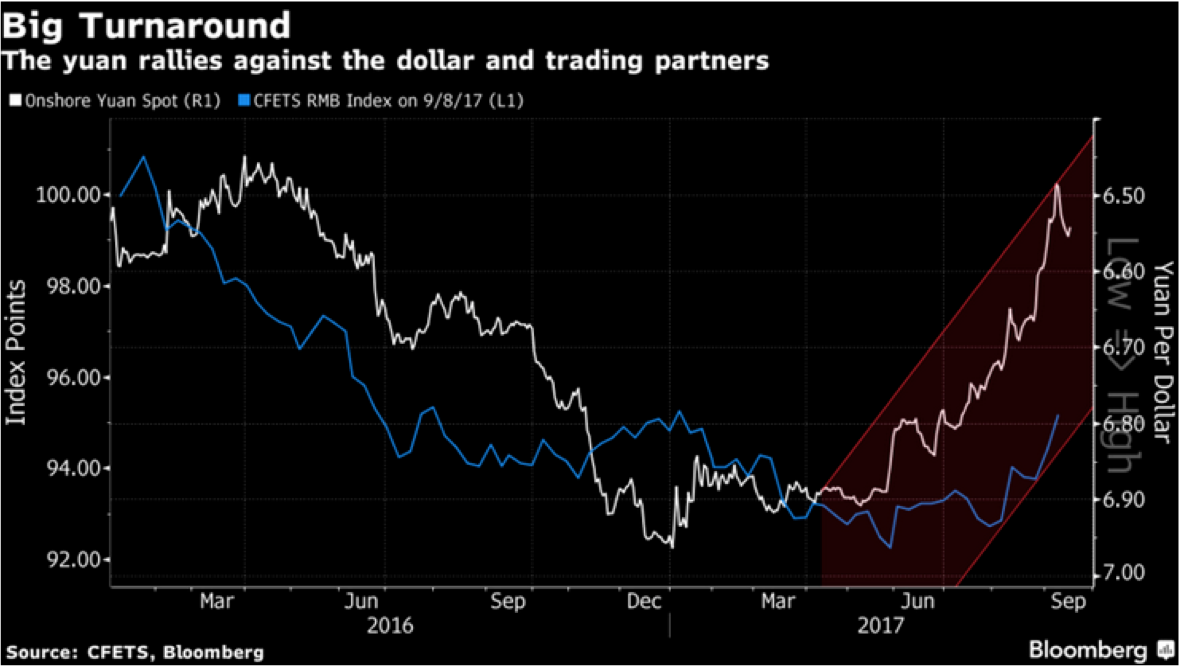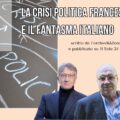In May, Chinese authorities revealed they would introduce a new “counter-cyclical factor” to the yuan’s daily fixing in view of giving “authorities more control over the fixing and restrain the influence of market pricing”. In other words, the daily $/CNY fixing mechanism introduced on January 2016 to balance the USD against a basket of currencies would include a correction, still undisclosed in details, to avert markets irrational expectations, which would result in “herd actions” with the risk of yuan overshooting.
So far the “counter-cyclical factor” has helped to shun downward pressures that have left the yuan fluctuating in a narrow band around 6.9 per dollar for most of this year.

The PBoC’s actions including stricter checks on capital outflow, and extra measure on exchange rate resonated like fresh evidence of China playing unfair game, pushing some critics to invite the IMF of ousting the yuan from the SDR.
Yet, alarms on yuan exchange rate are somewhat overblown. After all, the X factor, as dubbed in some media, didn’t feed in lowering the Chinese currency. The yuan started appreciate in the second half of the year by around 3.3 percent against the US dollar, with exchange rate at 5.7 percent advance against the dollar and up by one percent against the euro. The impact shows in exports, which due to a stronger yuan, slowed down to the U.S. and the European Union, China’s two biggest markets, making 8.7 per year-on-year to the U.S. From an almost 20% rate in June, while those to the EU lessened to 10.1% year-on-year from 15.2% the previous months.
The dynamics of the yuan exchange rate could turn a major outcome of this summer. The yuan floating into a some kind of two-way volatility seems a prelude to a run-up to boost extensively the yuan exchange rate flexibility.
The fact that the refinement of the exchange rate regime with the “counter-cyclical factor” almost occurred in sync to a weaker dollar has helped the yuan advance to a nine-month high against the US currency. Currently the US dollar index, which compares its value with a basket of six developed currencies, floats at a near one-year low as the value of the greenback weakens.
If the dollar’s slow decline against all currencies accelerate, or even collapse, what role should the yuan play in Asia and elsewhere?
In the dollar failing, Patrick Artus of Natixis sees playing mostly structural factors: a persistent US external deficit, which stands as the medium-term determinant of the dollar’s exchange rate, and uncertainty over the Trump’s economic policies, especially the reform of taxation. For these considerations the Federal Reserves could be induced to dilute its much anticipated restrictive monetary policy. These circumstances could promp to reverse markets positions vis-à-vis the dollar.
A weakening dollar, though, is not a major factor for the yuan strengthening. China’s economic growth at 6.9 percent and the widening usage of its currency in trade and investment speak high for it. Even if it is not yet clear that the yuan is the Asian anchor currency its use in pricing and settling intra-regional trade and investment is on a rising trajectory. According to BIS in three years (2013-2016) the yuan doubled its share, to 4%, to become the world’s eighth most actively traded currency and the most actively traded emerging market currency, overtaking the Mexican peso. As BIS found “ the rise in the share of yuan was primarily due to the increase in trading against the US dollar. In April 2016, as much as 95% of renminbi trading volume was against the US dollar” (www.bis.org/publ/rpfx16fx.pdf )
A further factor of the yuan monetary and financial projection is The Belt and Road Initiative (BRI) that for involving 63 countries and for its multi-faceted strategy will predictably boost trade, capital and services between China and the rest of the world. The flurry of economic deals will allocate an increasing influence to the yuan, with potential implications of its value and stability for perceptions of other partners’ currencies. Thus, the stability of the yuan, or more explicitly that it is not set to decrease in value, will reverberate positively in investors’ confidence in holding other Asian currencies.
A further factor that will add to the strength of the yuan is its volatility vis-à-vis Asian partners’ currencies. As central banks will need to smoothing out exchange rate volatility, they should hold yuan’s rather than euros and US dollars, so they will be slashing the size of the related reserves and widen the share of the Chinese yuan.
At this point, major outcomes can originate from Asia which stretch beyond the regional monetary relations. Asia’s region accounts for more than half of global central bank reserves, China alone holding 30% of global reserves, and Taiwan, Korea, India, Hong Kong, Singapore, and Thailand sitting among the top 15 reserve holders. If emerging central banks should start reallocating foreign exchange reserves in euros and dollars into yuan denominated assets, these developments could turn, according to Robin Winkler et Alii “ the region the biggest swing factor in anticipating how reserve trends will evolve (Deutsche Bank 2015).
Wrapping up, the Chinese yuan is set becoming later this or next decade the Asia’s reference currency. At the same time, yuan’s higher volatility would trigger sooner than later a foreign exchange reserves reshuffling in China’s trade partners, especially in Asia. An SDR currency the yuan will make it easy for the IMF not opposing that increasing shares of emerging banks precautionary reserves to be denominated in the Chinese currency.
Why then still delaying a free-floating yuan?

Share


















Lascia un commento